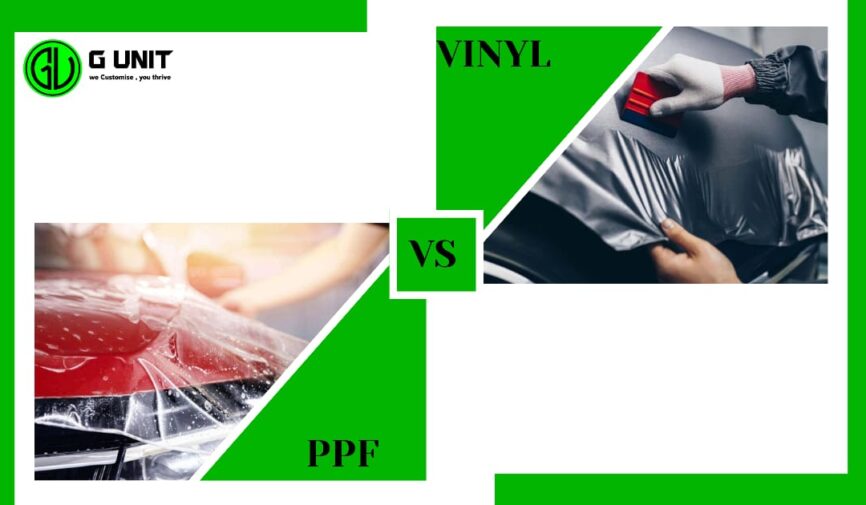PPF vs Vinyl Wrap: How to Determine the Best Film for Your Needs
The road can be harsh on your car’s paint, but damage doesn’t have to be permanent. That’s where protecting films like PPF (Paint Protection Film) and Vinyl Wrap come in. These films are gaining popularity as a way to shield your car’s exterior, but they serve different purposes.
To understand which film is right for you, it’s important to consider your individual needs and budget. G-Unit Automotive is here to help you discover the best options for protecting and enhancing your vehicle. Let’s explore the key differences between PPF and Vinyl Wrap so you can make an informed choice.
What are Paint Protection Films (PPF)?
Paint Protection Film (PPF) is a clear, thin film that’s applied to your car’s paint to keep it looking its best. This film is made of a special material called urethane that can heal itself if it gets scratched. It’s like a shield for your car’s paint, protecting it from everyday wear and tear.
They come in several finishes – high-gloss and matte, advanced gloss, and more – and keep the original paint color of your vehicle. Also, PPF can have self-healing properties which indicates that the film can remove filler marks and scratches from the coating.
The lifespan of PPF is different mainly based on the film’s quality and external environmental factors. On average, it will last you between 5-10 years if you treat it with care, but washing it regularly and detailing it when necessary will ensure your PPF continues to protect your car and looks good.
What is a Vinyl Wrap?
Vinyl wrap is a type of thin adhesive film, generally made from polyvinyl chloride. This piece is meant to preserve your coating from the harmful effects of UV and to make the appearance more attractive. The product has many types described below:
- Cast vinyl: The top-tier option, offering superior durability, flexibility, and longevity.
- Calendered vinyl: A more affordable choice, but less durable and comfortable than cast vinyl.
- Color-change wraps: Available in a wide range of colors, allowing for a complete makeover of your car’s look.
- Printed wraps: Showcase custom designs, graphics, or patterns, limited only by your imagination.
Vinyl wrap can last between 2 and 5 years. It depends on the quality of the material used, as well as the quality of the installation and how well it’s been cared for. You can protect your purchase by not washing it with abrasive materials, or using harsh chemicals. It’s also a brilliant way to personalize your car and turn your ride into a mobile masterpiece.
PPF vs Vinyl Wrap: Comparison
While both PPF and vinyl wrap offer protection and aesthetic enhancements for your car, they cater to different needs. Here’s a closer look at their key differences:
- PPF is used to shield the original paint and, at the same time, reinforce the outlook by employing an invisible layer inhibiting the impact of the outside temperature. It is infinitely more resistant and self-healing, making it a perfect long-term solution for a vehicle. However, such a feature comes with its price.
- Vinyl wrap represents the best solution if a person wants to change the appearance of the car. It is not as durable as the PPF but gives way for absolutely any customization – one can make it any color or add any pictures due to an extensive range of vinyl.
Your decision on whether to install one or the other ultimately depends on how much you value your car’s longevity. If the answer is “tremendously” and you prefer to avoid addressing preventable issues regularly, a PPF is the right choice for your vehicle. However, if you are willing to trade some level of protection for the ability to create a loud statement and emphasize your car’s exclusivity, you should give a vinyl wrap a shot.
Consider your budget, desired level of protection, and how long you plan to keep your car. It’s also crucial to consult with a professional installer to get expert advice and ensure proper application for optimal results.
Choosing Between PPF and Vinyl Wrap
Deciding between PPF (Paint Protection Film) and vinyl wrap comes down to your personal preferences and budget. Here’s a breakdown to help you choose:
Prioritize Ultimate Paint Protection:
- If your top concern is safeguarding your car’s paint from scratches, chips, road debris, and environmental damage, PPF is the clear winner. It’s the ultimate armor for your car’s finish.
Looking for a Unique Style:
- If you want to transform your car’s look with a custom color, unique finish, or eye-catching pattern, vinyl wrap is the way to go. It’s a fantastic way to express your personality through your vehicle.
Budget Considerations:
- Vinyl wrap is generally more affordable upfront than PPF. However, PPF’s long-lasting protection and potential to reduce the need for costly repaints can make it a wise investment in the long run.
Consider Your Driving Habits:
- If you frequently drive in harsh conditions, off-road, or own a high-end vehicle you want to keep pristine, PPF offers the best protection and will maintain your car’s resale value.
Professional Installation is Key:
- No matter which film you choose, professional installation is essential for a seamless finish and optimal longevity.
Still Unsure?
G-Unit Automotive can guide you through the selection process, helping you weigh the pros and cons of each option and determine the best fit for your vehicle and lifestyle. Contact us today to schedule a consultation and protect your car’s paint with confidence.
FAQs
We hope this covers the basis, but you might have more questions. Here we have answered the frequently asked question about PPF and vinyl wrap.
1. Can I remove PPF or vinyl wrap without damaging my car’s paint?
Yes, both PPF and vinyl wrap can be removed safely by the professional installer without damaging your car’s paint. You should avoid removing it yourself as improper techniques will result in paint damage.
2. Can I wash my car as before after applying PPF or vinyl wrap?
Yes, of course! After applying PPF or vinyl wrap, you can still wash and wax your car as before. But, do not use harsh chemicals or other abrasive materials that will damage the film.
3. Does PPF or vinyl wrap affect my car’s resale value?
PPF can actually increase your car’s resale value by keeping the original paint in showroom condition. Whereas, vinyl wrap will not add any value to the car but if it is done neatly then it may attract the attention of potential buyers.
4. Can I apply PPF or vinyl wrap myself?
While DIY kits are available, professional installation is highly recommended. It ensures proper application, prevents air bubbles and wrinkles, and maximizes the film’s effectiveness and longevity.
5. Which one is better for my car, PPF or vinyl wrap?
The best choice depends on your priorities and budget. If protection is paramount, choose PPF. For customization and a unique look, opt for vinyl wrap.
Conclusion
Whether PPF or vinyl wrap will be your main protection and customization companion depends on your personal priorities and budget. Nevertheless, both films will lend your car unique properties, from paint protection to extraordinary looks. Whether you want to pay for a wrap discreetly placed over your car for a dozen years or whether you prefer to show it off by changing its color every once in a while, you cannot make a mistake as long as you are perfectly aware of what PPF and vinyl wrap are.


